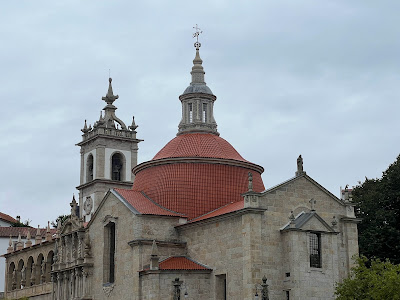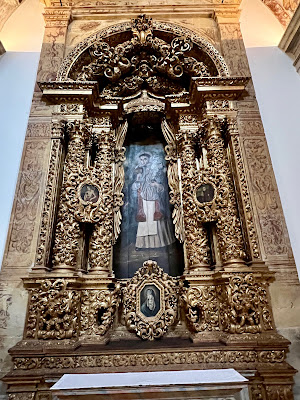In 1809, this bridge was the site of a battle between the forces of Napoleon and Portuguese troops. The Portuguese were able to hold off the French troops for nearly two weeks, allowing British troops in Portugal to attack other areas. However, once the French troops were finally able to capture the bridge, they pillaged and vandalized Amarante, making the Portuguese pay for their resistance. The photo above shows a sign commemorating the 100th anniversary of the battle.
Gonçalo quickly learned that his nephew had abused his position in the parish, using the money that was supposed to go to the poor to purchase himself fine horses and hounds. The nephew wasn't happy to see Gonçalo and had his dogs attack him. Before they could kill his uncle, they were called off and Gonçalo chose to leave the area, eventually settling in the hills of Amarante, living as a hermit. Over time, pilgrims came to see him, to hear him preach.
Through prayer, Gonçalo saw a new future for himself, which led him to joining the Dominican Order. He then returned to Amarante, to establish a church, and the people, many who had heard him preach before, eagerly flocked to him. He also became known as a miracle worker, and at least one of those miracles involved wine from an unlikely source.
Gonçalo was said to be the impetus for constructing a bridge over the Tâmega River. Legend claims that the bridge workers once ran out of wine, and were quite thirsty. So, Gonçalo split open his own head, from which wine poured out to slake the thirst of the workers. Another version of the legend claims that he only split open a rock, and wine poured out. When the workers were hungry, it's also claimed that Gonçalo called out to the fish in the river, who leapt onto the river bank, sacrificing themselves for the workers.
Gonçalo died on January 10, 1259, and he allegedly predicted the exact date of his death. Even after his death, people felt he still performed miracles, including appearing to various people. Pope Pius IV made him a Saint in 1561, and his feast day is January 10th.
The bottom photo shows an effigy of Gonçalo on his tomb, and it is often here that women come seeking his assistance for their love lives. Some leave flowers atop the effigy. It's also said that if a single woman pulls on the rope belt of the statue of Gonçalo, in the second picture above, they will find a husband.
Another famous symbol of Saint Gonçalo is the Bolos de São Gonçalo, the cakes of Saint Gonçalo, which are also known as Doces Fálicos, "phallic sweets." These penis-shaped cakes can be found throughout Amarante, from its bakeries to wooden stalls managed by elderly women. These cakes are supposed to promote fertility, but also are given to single woman as a charm to help them attract a husband. No one knows the origins of these cakes, and many suspect they extend back to ancient pagan practices. By some unknown twist of fate, the cakes became associated with Saint Gonçalo.
Initially, the cakes were created only on a couple religious holidays, in January and June, but eventually they started being made year-round. Around 1926, the cakes were declared obscene by the government and thus prohibited, although people still made them secretly. It wasn't until 1974 that the laws changed, and people could once again openly produce these cakes.


























No comments:
Post a Comment